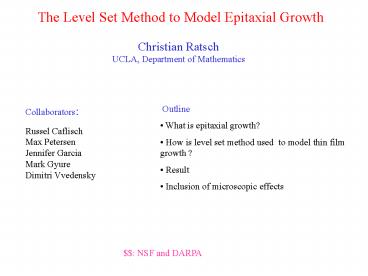The Level Set Method to Model Epitaxial Growth PowerPoint PPT Presentation
1 / 21
Title: The Level Set Method to Model Epitaxial Growth
1
The Level Set Method to Model Epitaxial Growth
Christian Ratsch UCLA, Department of Mathematics
Collaborators Russel Caflisch Max
Petersen Jennifer Garcia Mark Gyure Dimitri
Vvedensky
- Outline
- What is epitaxial growth?
- How is level set method used to model thin film
growth ? - Result
- Inclusion of microscopic effects
NSF and DARPA
2
The Island Dynamics Model for Epitaxial Growth
- Conventional Approaches
- Atomistic Kinetic Monte Carlo simulation
(stochastic, expensive) - Continuum Models (deterministic, lacks detail)
- Treat Islands as continuum in the plane
- Resolve individual atomic layers
- Velocity of island boundaries ?
- How do islands nucleate ? Where ?
- Evolve island boundaries with levelset method
- Treat atoms as a mean field quantity
3
The Level Set Method Schematic
- Continuous level set function is resolved on a
discrete numerical grid - Method is continuous in plane (but atomic
resolution is possible !), but has discrete
height resolution
4
The Level Set Method Formalism
- PDE - based method, almost deterministic !
5
Typical Snapshots of Behavior of the Model
t0.1
j
r
t0.5
6
Validation Scaling of the Island Size
Distribution
Q Coverage sav Average island size ns Density
of islands of size s
C. Ratsch et al., Phys. Rev. B 61, R10598 (2000)
7
A Typical Level Set Simulation
8
Decay of Step Edge Oscillations
Layer-by-layer growth persists longer with no
(slow) edge diffusion
9
Roughness Evolution
Surface roughens faster with fast edge diffusion
10
Adatom Concentration
Fast edge diffusion Compact Islands
Slow edge diffusion Fractal Islands
11
Effect of Edge Diffusion on Surface Roughness
Fast edge diffusion
No edge diffusion
12
Extension to Reversibility
- Remark Stochastic element in the break-up of
islands is needed !! - No frequent detachment/re-attachment needed !
13
Extension to Reversibility Sharpening of Island
Size Distribution
Experimental Data for Fe/Fe(001), Stroscio and
Pierce, Phys. Rev. B 49 (1994)
Petersen, Ratsch, Caflisch, Zangwill, Phys. Rev.
E 64, 061602 (2001)
14
Scaling of Computational Time
Almost no increase in computational time due to
mean-field treatment of fast events
15
Extensions and Applications of the Reversible
Aggregation Model
Ostwald Ripening (without flux)
- Strain dependent detachment
- Simple approach
- Simply make the detachment rate (i.e.shrink
velocity) size dependent - More sophisticated approach
- Solve elastic equations
- Couple with level set code
- Applications
- model formation and self-organization of quantum
dots - segregation at interfaces
16
Sharpening due to Island Size Dependent
Detachment (Strain)
Linear Increase
Linear Decrease
17
Atomic Size Effects
D/F106
D/F107
D/F108
- Island densities are too high
- Results of finite size of atoms (at the
boundary) - Idea Set r0 in a region of width a (atomic
lattice constant)
18
Estimate Atomic Size Effect
19
Implementation of a Boundary Region
20
Results for the Island Densities
D/F106
D/F107
D/F108
C. Ratsch et al., Phys. Rev. E 64, 020601 (2001)
21
Conclusions
- We have developed a numerically stable and
accurate levelset model to study epitaxial growth - Spatial fluctuations are needed in the seeding of
new islands - Microscopic details such as detachment and edge
diffusion can be included
- Future Directions
- The levelset method provides a natural framework
to couple other external fields such as strain or
hydrodynamics to the growth modeling - Multiple species can be described with multiple
(coupled) diffusion equations - Include surface chemistry (surface
reconstrcutions) Talk tomorrow, 430pm
Transparencies of this talk can be found at
www.math.ucla.edu/material

